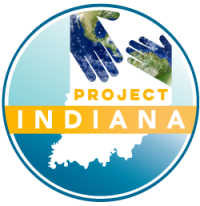Author: Amber Knight
Sweat Equity
Guatemalans say ‘Si, si’ to helping run power lines
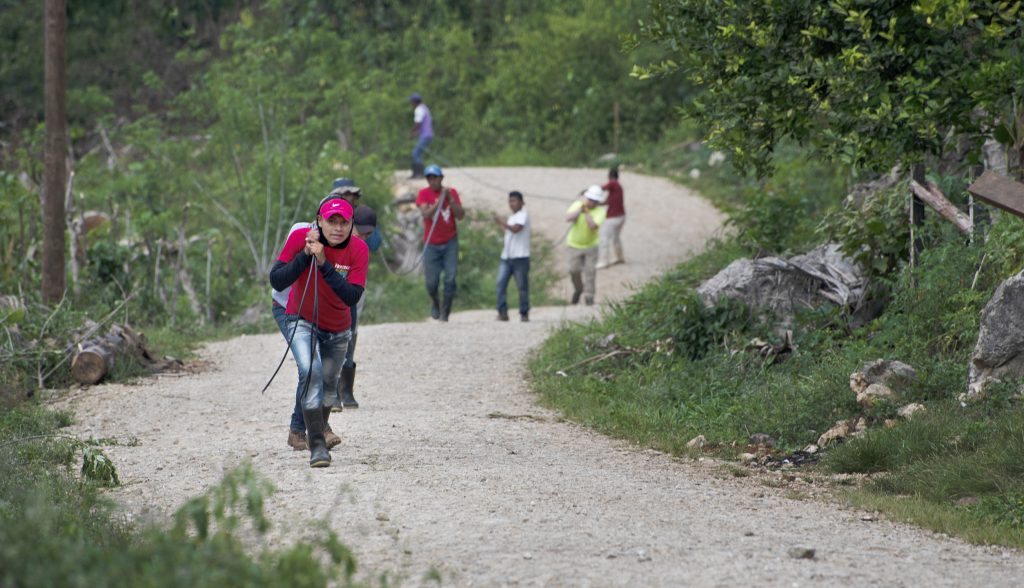
The lean Guatemalan wielding the machete couldn’t be missed in his cardinal red T-shirt against the thick green brush. Leading the way up a steep hillside, he quickly cleared a path for the crew of volunteers pulling the heavy electrical service line. Together, they trudged through the tall weeds and stalks of corn to the pole beside the next home in line.
Later, that same afternoon, there he was again. Now, joining others, he helped pull more line along the main gravel road from the center of San Jacinto to the farthest poles of Project Indiana’s 2019 build in east-central Guatemala. The two-week project, which electrified some 90 homes, two churches and a school, included 14 Indiana electric cooperative lineworkers and four coordinators and support staff.
Considering the day’s heat, humidity and the hills and hollows he crossed, Christsanto Tuil Caal had all the stamina you’d expect from a guy wearing that red shirt — which touted “Willmar Cross Country.”
The logoed shirt, like so many the locals wear, had come from a periodic drop of American clothing. The 35-year-old said he grabbed the shirt because he liked its image of two hands creating a “W” (which represented the high school in Willmar, Minnesota). He didn’t know the double Cs with an arrow through them stood for the endurance running sport. When asked about the shirt, he replied with a grin that he thought “CC” was just saying, “Yes, yes” … which in Spanish, it does (“si, si”).
As the old saying goes, many a truth is told in jest.
Christsanto said “yes” — multiple times — when he heard about the American lineworkers coming to extend power lines and that volunteers were needed to help. He answered the call, though he doesn’t even live in San Jacinto. Christsanto and his family live about five minutes up the line from where the electricity originally ended. He’s enjoyed electricity at his home and small coffee plantation for almost 10 years, he said.
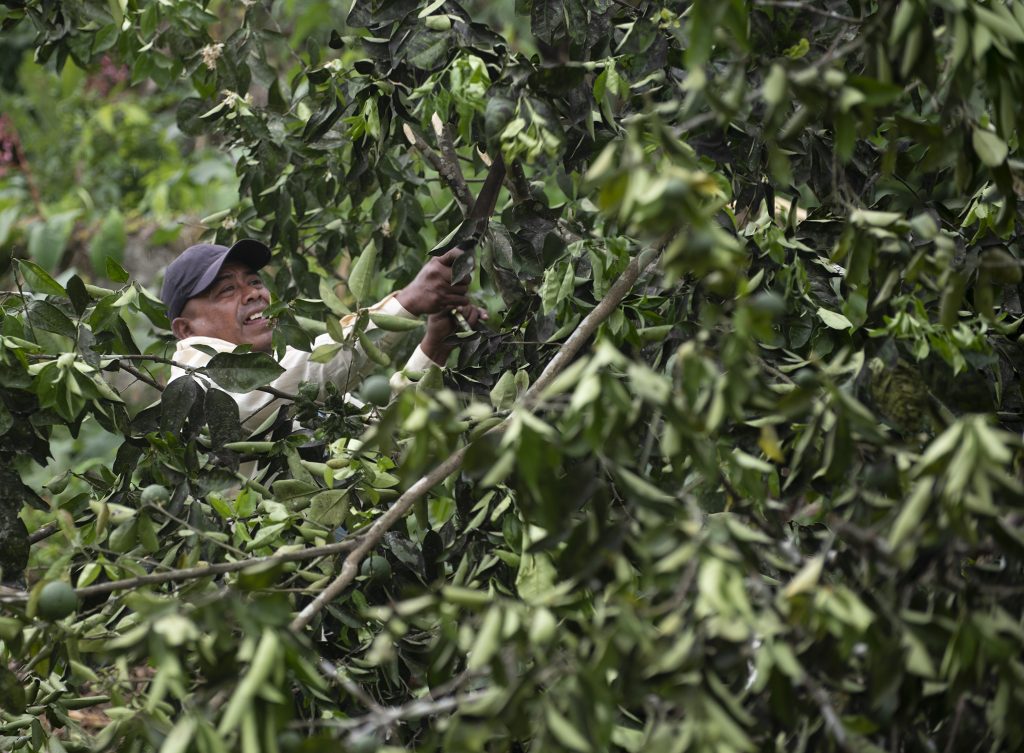
But the father of three said he knows electricity will benefit his neighbors — especially their children. Helping do the manual work he knows how to do so well, he said, is his way to contribute. “I do it now because I’m still strong,” he said, speaking through an interpreter in his native Mayan language, Q’eqchi.
As with the previous Project Indiana trips, the work ethic of the local folks impressed and inspired the Hoosier lineworkers. Every morning, a group of men from the village gathered outside the warehouse, awaiting the arrival of the Project Indiana team from the town of Chahal where they stayed. The locals then split up with the different crews to either build power lines or wire homes. “Carrying tools, digging holes, setting poles — anything we needed, they were right there on it,” said Jamie Bell, a construction engineer from NineStar Connect, who served as a coordinator on the trip.
San Jacinto villagers already had set 50 poles before the Indiana crew arrived in March. Without the modern equipment used by lineworkers in the States, the villagers dug the 6-foot deep holes and raised each pole, weighing some 700 pounds, into place — all by hand. Another five poles were set by hand while the Indiana crew was there.
As the local crews worked side-by-side with the Indiana lineworkers, especially while wiring the thatch-roofed homes, the church and school, they’d watch intently. And the Hoosiers imparted their skills through the Spanish- and Q’eqchi-speaking interpreters or through hand motions, broken Spanish and examples if the interpreters weren’t handy.
Wiring the homes was slow at first, and there was concern that part of the project was going to take longer than planned. But over the course of the two weeks, the two groups developed a rhythm and a sense of understanding that made the work flow smoothly.
The Indiana crews wrapped up building the power lines and wiring the homes even a couple of days ahead of time. “We would not have been able to get it done without their help,” Jamie said.
Powering Up
Market owner says electricity means progress and opportunities for village
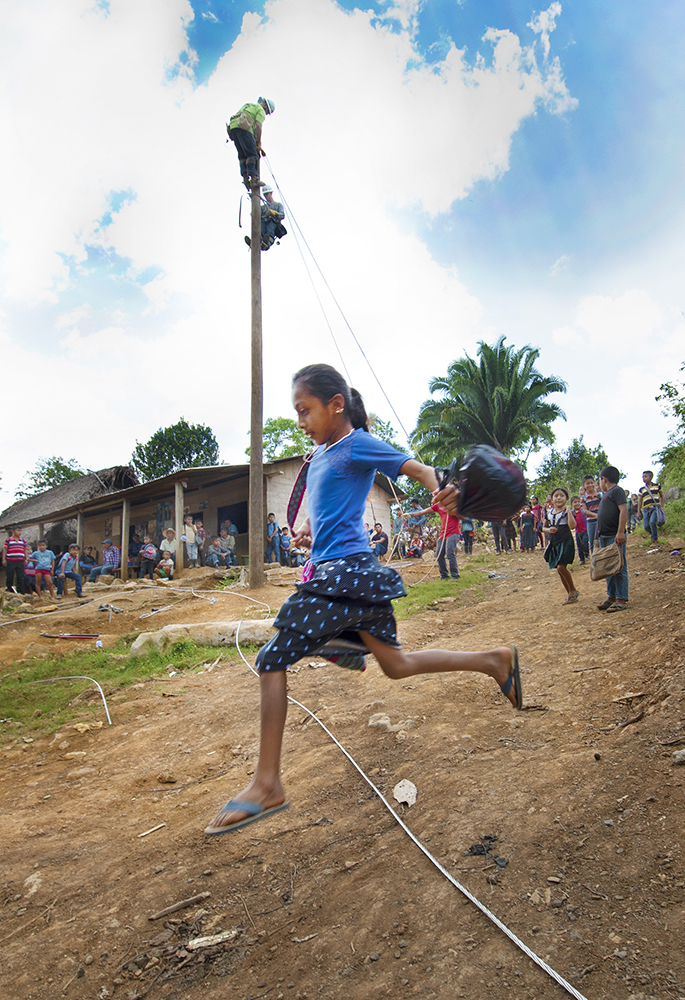
The day always started earlier for Macario Choc Cucul than for most in his little village of San Jacinto in east central Guatemala.
Every morning at daybreak, Macario left his wife, 18-year-old daughter, and 7-year-old son, and motored along the rutted gravel and rocky roads between San Jacinto and his brother’s home about a half hour away.
Macario and his family own and operate what might be considered the largest convenience store in San Jacinto. Their store, which doubles as their home, sits right by the sign that welcomes visitors along the only gravel road through town. And it’s fortuitously situated at the “T” where a dirt and rocky road takes off up over a steep hill to the village school and other homes and a church farther up. It’s a popular gathering place for the local men to visit while having a cold soda. And it’s the last or first stopping off spot for kids walking to and from school for snacks — like chips, ice cream, or a squeeze tube of frozen flavored custard or ice.
Until electricity came to the village via Project Indiana’s 2019 undertaking, just making sure he could keep the cold products cold throughout the steamy afternoons was a big part of Macario’s early morning chores.
Macario already owned two refrigerator/freezer units. But he had to keep them at his brother’s home which is in one of the 12 small towns electrified in the Las Conchas area a decade ago. So, at his brother’s home, Macario, 40, would have to load up coolers with ice, cold drinks and other cold snacks, and then drive the half hour back to his store to sell the items during the day.
Having electricity at the store will mean moving the refrigeration units on site … and so much more.
“Electricity means progress,” he said through an interpreter in the Mayan language of Q’eqchi spoken throughout the region. “It means better opportunities in the community.
“In school,” he said, “kids will have opportunities to learn about computers, have a laboratory, TV, and videos.” And he noted lights in the school will allow longer study times into the later afternoons and perhaps, at some point, air conditioning.
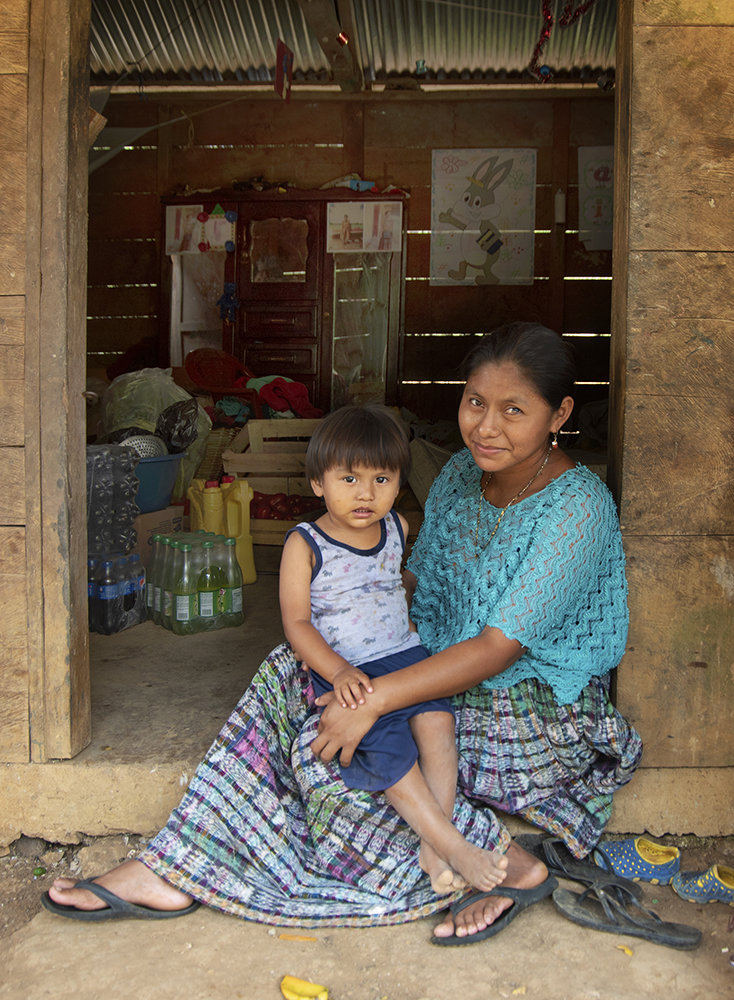
Macario said his family came to the Las Conchas area from Cobán, the capital of the department of Alta Verapaz, when he was in his teens. They had electricity there, he said, but he couldn’t really recall how the move affected him and his family at first. That was a quarter century ago. His father, a farmer, bought land in the Chahal municipality when larger parcels of land could no longer be purchased in Cobán. Macario’s siblings divided the land among themselves and, 18 years ago, he opened his market in San Jacinto.
Alongside the front of a thatch-roofed part of the store, stacks of crates await his next trip into the city of Chahal. There, he fills them with produce he purchases at the open market and resells in San Jacinto. His market also sells beef and chicken. Chocolate-covered bananas are also popular with youngsters, he said.
While many in San Jacinto said refrigerators would be high on their list of first appliances once electricity arrived, Macario and his family were considering a computer and a TV for the family. He said he’d like to see San Jacinto eventually build a public library, too, to make higher-tech electronics available to everyone.
With Guatemala being the number one country from which illegal immigration to the United States originates, Macario said development like electricity is key to keeping folks grounded to their home. “Some people will go away from here without electricity for better opportunities,” he said. “Now, with electricity, they will stay.”
And for electricity, he is grateful on this particular late March afternoon in 2019 to Project Indiana and its dedicated lineworkers who are building power lines throughout the town. “God will bless you,” he said for their efforts.
Better diets in the refrigerator light
It’s the middle of a hot sunny afternoon, and San Jacinto is quiet — except for the persistent crowing of a time-warped rooster across the road from the green concrete-block Catholic church, just down the hill from Macario’s place. Project Indiana lineworkers have fanned-out from the center gathering point at the church and are off building tap lines in the karst hilly landscape above the town and in both directions along the main road.
In the shade of the front porch of their home and store, Macario’s wife, Petrona, fires up propane burners beneath two deep vats filled with cooking oil. Soon, she drops breaded chicken into the boiling oil. The frying sounds like hard rain when it falls on the tin roofs overhead. Using metal tongs, she reaches into the vats, moves the pieces around and talks to passersby. She occasionally lifts a piece out for a looksee, and drops it back in.
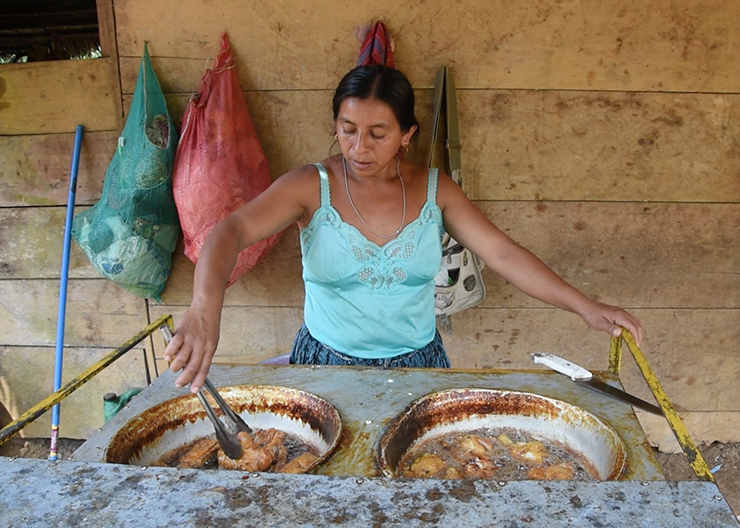
Finally, a drumstick is ready. She grips it tightly with the tongs and bangs the metal utensil against the side of the vat to shake excess oil from the chicken and sets it on a plate. She finds another piece and places it beside the first piece. Then, she tops them with a variety of sauces from squeeze bottles and sets the plate out to entice customers to purchase the chicken as she continues cooking. Once all the pieces are fried, she moves them from the oil to a pot and shuts off the propane tank.
While electricity may not replace the propane burners anytime soon, certainly the refrigeration units on site — and in the homes of residents in San Jacinto — will aid Macario and Petrona’s efforts to sell meats and other products, and they’ll be able to offer more variety.
Just as the refrigeration that came with electrification made a huge impact on improving the diets and, along with that, the health of rural Americans in the 1930s and 1940s, it’s expected to do the same with the villagers of San Jacinto.
And, along with improved diets, there’s a simpler pleasure folks there may soon discover with electricity and appliances: The joy of treating themselves to a midnight snack of leftover fried chicken — snatched cold, straight from a plate by the refrigerator light.
San Jacinto’s Power Supply
A look at the small hydroelectric generating station that serves the village
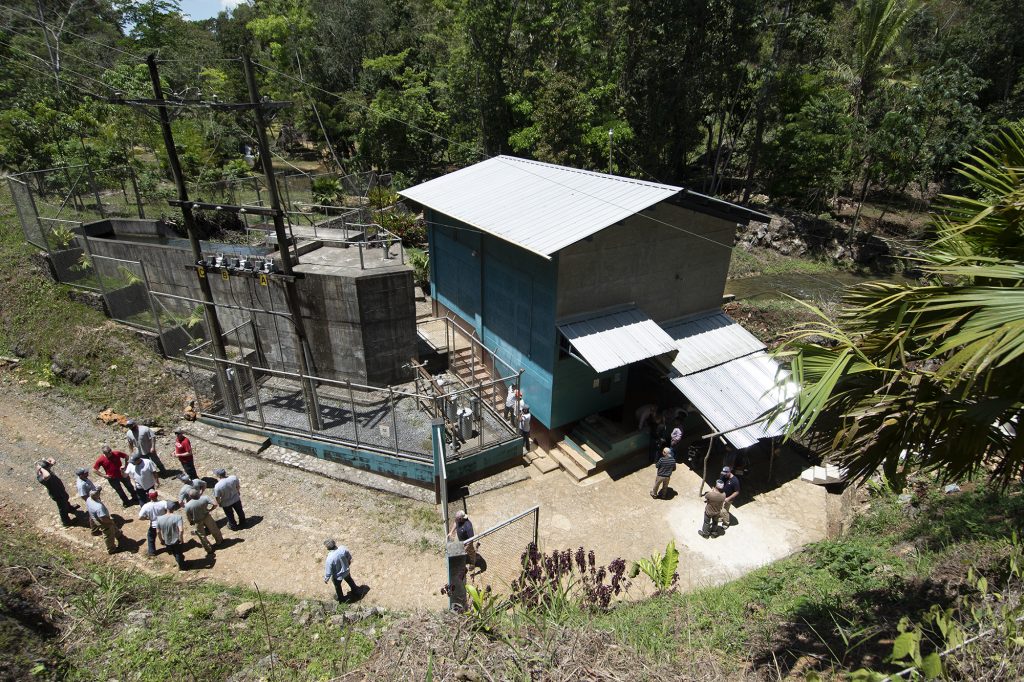
In April 2019, 18 Indiana electric cooperative lineworkers and staff returned from rural Guatemala after extending power lines into the tiny village of San Jacinto. It was the fourth trip of a continuing initiative, “Project Indiana: Empowering Global Communities for a Better Tomorrow,” that began in 2012.
The crew spent just over two weeks building power lines and wiring about 90 homes, two churches and a school campus in the eastern department of Alta Verapaz.
But before Project Indiana lineworkers can put boots on the ground to build power lines on any of their trips, the electricity has to be there. The power supply for San Jacinto was a micro hydropower generating station.
On the way to San Jacinto, the lineworkers along with Hugo Arriaza, Project Indiana’s Guatemala-based contractor who oversees most of the logistics for the crews, stopped to tour the power station along the Chiyú River. The Hoosiers were surprised to learn the generator and distribution lines to 12 nearby villages, which they were about to tap into for San Jacinto, were built by a Japanese government agency.
“Hugo wanted us to see where the source of power came from,” recalled Jamie Bell, a construction engineer for NineStar Connect who was a coordinator on the trip. “I thought it was pretty interesting what the Japanese did for the community.”
Guiding the tour of the power station tour was Victor Pzalam, acting administrative coordinator of The Farmers Development Association, the local utility that operates the power station and maintains the lines serving the Las Conchas area.
The Japan International Cooperation Agency began working with the Republic of Guatemala just over 10 years ago. The Japanese governmental agency assists economic and social growth in developing countries around the world.
Since the late 1990s, Guatemala’s electrification rate rose from 60 percent to 86 percent, mostly by expanding its grid. But just like in the United States 100 years ago, the most rural regions of Guatemala were left out of the expansion. Difficult terrain along with the high rates of poverty in the rural areas hampered grid development. In the most rural areas of Alta Verapaz, where more than half of the people live in extreme poverty, for instance, the electrification rate was less than 15 percent.
Through an $11 million grant, the Japanese agency built small-scale hydroelectric plants in three impoverished areas — Las Conchas, Seasir and Jolom Ijix — and provided technical support. JIUC completed the projects in 2014 and continues monitoring them.
Sepamac, the village electrified by Project Indiana’s 2015 trip (about 30 miles to the southwest of San Jacinto as the quetzal bird flies — but over 110 miles via primitive roads), was powered by the hydroelectric station at Seasir on the Cahabón River.
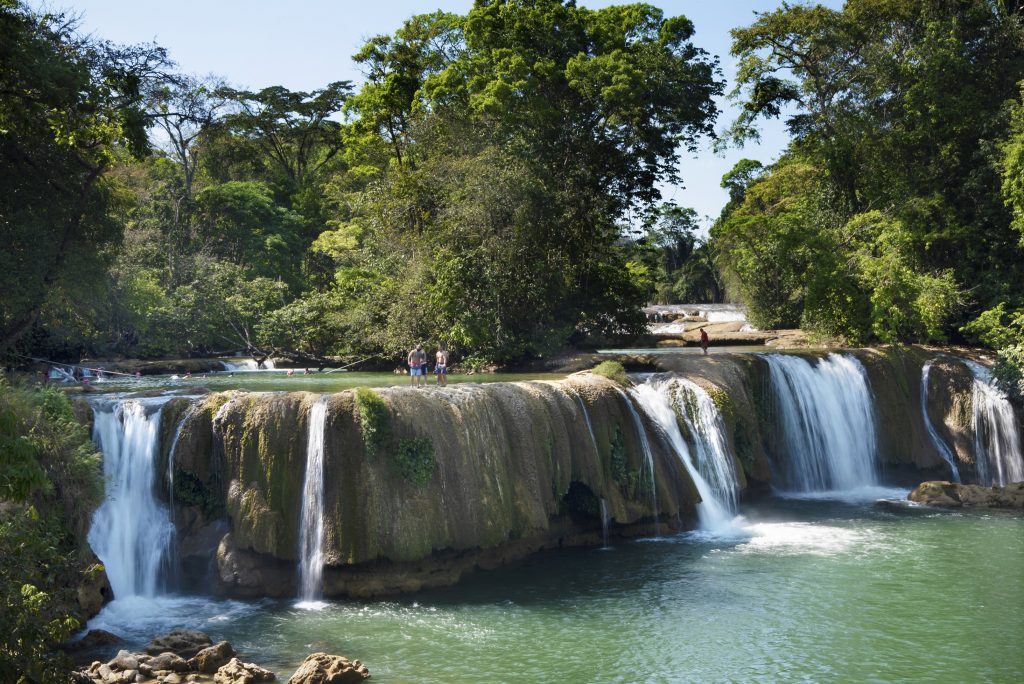
The hydropower station at Las Conchas did raise concern among the people in the area because of its proximity to Las Conchas waterfalls and nature park. The beautiful falls and turquoise pools are a tourist attraction and source of pride for the area. The power station is just a skipping-stone’s throw upriver from the falls within the park’s boundaries.
Las Conchas is the Spanish translation of the place named Se Pemech in the local Q’eqchi’ Mayan language. It means “the snails.” It refers to the many piles and deposits of mollusk shells found near the falls. The abundant, edible snails have been an attraction for the local indigenous population for countless generations. Great care was taken to mitigate any effects the power station would have on the water flow and the flora and fauna of the park and the falls.
“The generation plant was smaller than I thought it would have been,” noted Bell, “but it goes to show there isn’t that much load.”
Even with the addition of San Jacinto, bringing the total homes and buildings served by the hydro plant to around 550, the Chiyú River power station — with a 150 kw capacity — could handle another four or five times more, Pzalam noted. Most of the electricity used in the Guatemalan homes is for lighting and refrigeration. By typical American standards of power use, the station would power maybe seven homes at best.With the development Project Indiana hopes it has helped nurture, future challenges for the rural Guatemalan utilities will be finding new sources of power to supplement and back up the generation they already have. These are challenges Project Indiana is also willing to help utility officials face as they continue powering rural Guatemala to a brighter future.
Matters of the Heart
Guatemalans express gratitude for Project Indiana with universal symbol of love
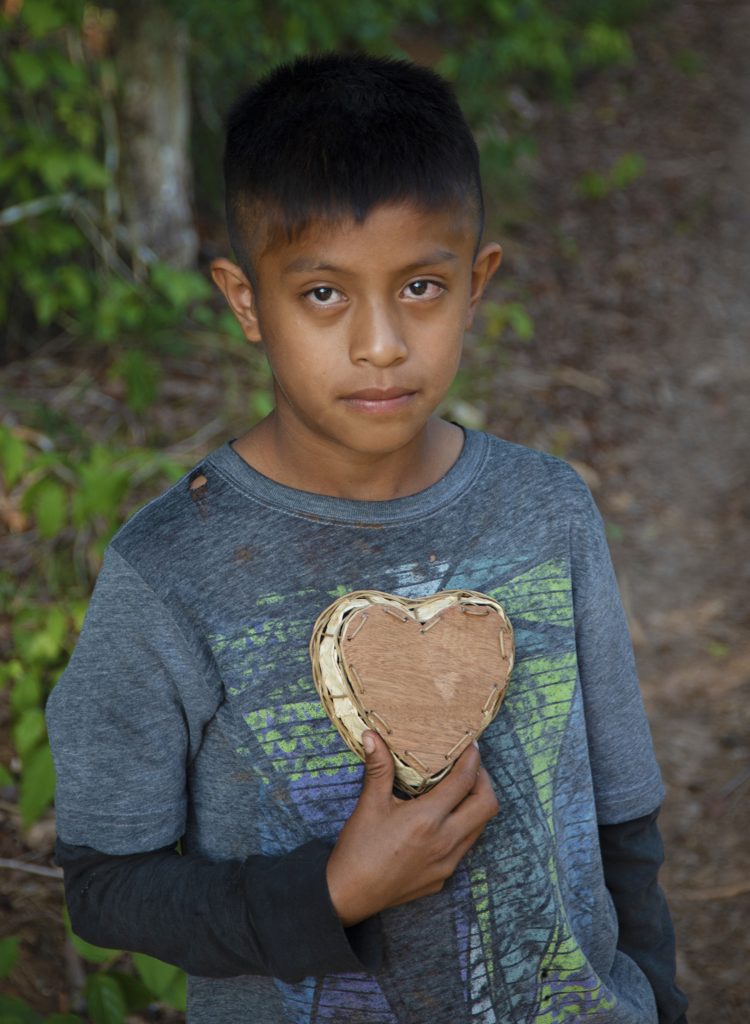
Not one of the 18 Indiana electric cooperative lineworkers or support crew who traveled to Guatemala in spring 2019 as part of the continuing “Project Indiana” initiative spoke Q’eqchí, the indigenous Mayan language where they traveled. But they understood the gratefulness of the villagers of San Jacinto who spoke with their hearts.
The universal symbol for love and affection was displayed to them time and again by villagers — just as it had been on the three previous trips Project Indiana has made to Guatemala since 2012. Through both the symbol and words translated from Q’eqchí and Spanish, the heartfelt thanks warmed the hearts of the Hoosiers who came to extend power lines into their eastern Guatemala village.
The fourth Project Indiana trip was March 24 – April 9, 2019. On this trip, the crew worked in the Alta Verapaz Department near its border with the department of Petén. The 2015 trip also worked in Alta Verapaz but farther to the south and west. Trips in 2012 and 2017 were in the northwestern mountainous regions of Guatemala near the southern Mexican border.
As crews wired the 90-some homes for the electricity that was to soon be flowing, one came upon a sign 3-year-old Marco Bicbai Cancucul had left along the dirt path up that led to his front porch. He may not have meant it specifically for the lineworkers, but there lay a heart sculpted from a foot-long piece of wire. Other strands the short scrap were poked into the ground.
Marco’s home was through some dense foliage in the center of the village just behind the warehouse the crew used during their three-week project. Marco probably pulled the strand of wire from a scrap pile the linecrew started when cleaning out trucks at the end of each day.
His mother said Marco liked pulling apart the twisted strands and then creating shapes with the individual strands. Shy at first, Marco then seemed to take pride in showing off his heart and posing for photos with it across his chest.
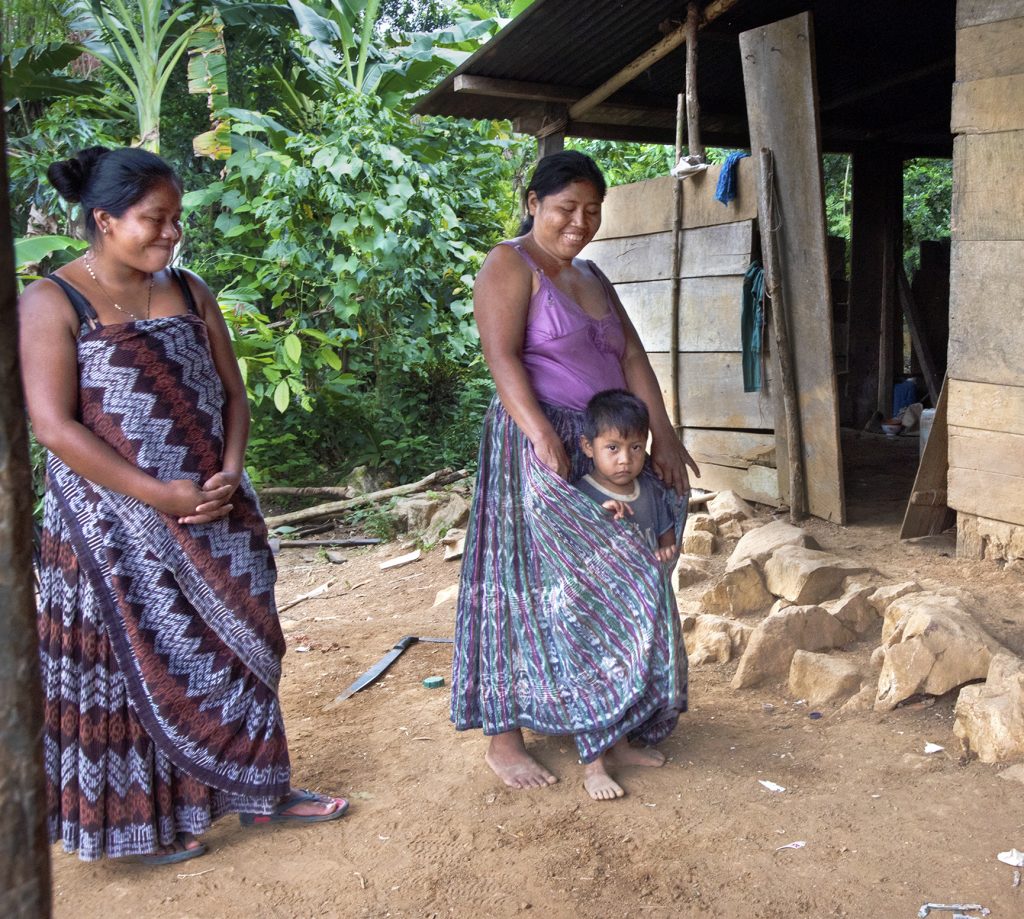
Marco is the youngest of six siblings. The rest were at school that day. Their parents said they hope having lights at night will help their children study better to prepare for school. And they hope adding new electric appliances will make their hardscrabble lives a little easier.
Atop one of the steep hills at the far end of San Jacinto, a boy, probably in his early teens, stood in the shadows of trees on a late afternoon tapping his machete on wood. When he’d finally caught the attention of the Hoosiers working nearby, he held up a little basket to his chest. Its wooden bottom was fashioned from the machete also in the shape of a heart; its sides were woven from long blades of butter-colored grass held in place by small sticks glued together. The boy later gave the basket as a gift to Travis Goffinet when the lineworker from Southern Indiana Power came to make sure the lights were on when the electricity started flowing throughout the village.
In 2015, when Indiana also worked within the region, young girls showed their appreciation by forming hearts with their fingers and hands.
For Enrique Rax Yat, home is where the heart is. The 45-year-old San Jacinto community leader, like so many of the community leaders who serve on electric co-op boards in Indiana, is also a parent. Like them, he wants to see his four young adult children find opportunities nearby and be successful and raise their families there. He doesn’t want to see them go off to larger distant cities in Guatemala or even the United States to find their futures.
Enrique was among those who first began asking that the area’s utility, Farmers’ Development Association Las Conchas, extend its power lines to San Jacinto six years ago. He now represents San Jacinto at the association. “Electricity will give them opportunities to compete to achieve something more,” he said of his children and the children of the village.
Enrique and his wife were home when the electricity was turned on April 2. “It was beautiful,” he said. “I prayed, ‘Thank you, God, for this achievement.’” And he thanks Indiana.
“I can’t describe it. Words and pictures don’t do it justice,” said Jamie Bell, a coordinator of the San Jacinto project from NineStar Connect. Bell has left a little bit of his own heart in Guatemala. And, since coming home from what was his second project there, he has joined the non-profit Project Indiana board.
“You see how hard they work for the little they have,” Bell said. “Electricity gives them a powerful tool to better themselves — to make them want to stay there. With it, they’ll have better health, better schools, just an all-around better way of life. I just feel as if there’d be something wrong with any of us if we didn’t want the best for people like that.”
In other words, helping good and grateful people — whose lives are so hard and have so little — through Project Indiana is yet another way Hoosiers continue to show they, too, have a heart.
